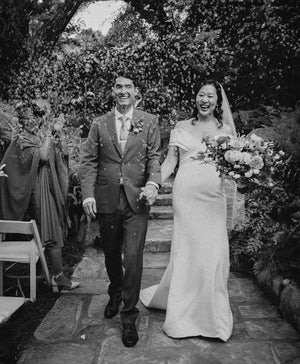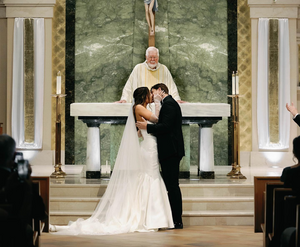You may also like
The wedding veil, an iconic symbol in bridal fashion, holds a wealth of history and meaning that spans across cultures and centuries. Originally believed to offer protection and symbolize purity, the wedding veil has evolved into a versatile, fashionable piece that complements contemporary bridal gowns.
But why do brides wear veils today?
While modern brides may wear a wedding veil to add elegance to their look, the tradition carries deep significance, making it a choice rooted in both style and sentiment. This blog explores why brides wear veils, delving into the rich history of the wedding veil, its meaning across different cultures, and the reasons brides still choose to wear veils today.
Why do Brides Wear Wedding Veils Today?

One of the main reasons why brides wear veils today is to strike the delicate balance between honoring tradition and making a personal statement. The symbolic meaning of bridal veil represents this perfect blend of past and present traditions. The wedding veil offers brides the chance to connect with a time-honored custom while also embracing their own unique style.
From a short, playful elbow-length veil to a grand cathedral-length veil, brides have the freedom to choose how they wish to incorporate this iconic symbol into their wedding day, which opens brides up to countless avenues for self-expression.
Many modern brides also wear veils as a way to elevate their bridal look. Embellished with lace, embroidery, 3D floral details, or beading, the veil becomes a stunning piece of art that adds elegance and sophistication. For some, the connection to tradition is meaningful, while others appreciate the dramatic flair that a beautifully designed veil brings to their overall bridal ensemble.
The History of the Wedding Veil
The tradition of wearing a wedding veil dates back thousands of years, with origins in ancient Greece and Rome. In these societies, it was believed that the veil would protect brides from evil spirits who might be drawn to the joy and happiness of their wedding day. The veil was considered a safeguard, providing a barrier against malevolent forces that could interfere with the bride's new beginning.
The wedding veil also served a ceremonial purpose. In arranged marriages, particularly in ancient Rome, the bride's face was often concealed from the groom before the ceremony. The history of wedding veils stretches back to these early customs, where superstition held that it was bad luck for the groom to see the bride before the wedding, a belief that has carried to this day in many parts of the world. The lifting of the wedding veil during the ceremony symbolized the bride's transition from her family's care to her partner's, marking the start of their new life together. Many brides today wear a veil to continue this ancient tradition of protection and embracing new beginnings.
During the Middle Ages, the wedding veil took on additional layers of symbolism. It represented purity, modesty, and chastity, virtues highly valued in women at the time. In religious ceremonies, the veil was a sign of the bride's humility and reverence before God. As these meanings became ingrained in wedding traditions, the bridal veil was forever linked to spiritual and social expectations surrounding marriage.
The Cross-Cultural Symbolism of the Wedding Veil
Though the bridal veil is primarily associated with Western weddings, its significance extends across various cultures, each interpreting the tradition in its own unique way. Why do brides wear veils in these different cultural contexts? Let’s take a look:
In Indian Weddings
The “ghoonghat” or “dupatta” serves a similar role to the Western bridal veil. It is used to cover the bride’s face as she enters the wedding ceremony, symbolizing modesty. In this context, wearing the veil is seen as a sign of purity and respect, and lifting it is the start of a new beginning.

In Jewish Weddings
A reflection on the biblical story of Jacob and Rachel, the custom of “badeken” involves the groom veiling the bride before the ceremony begins. This gesture signifies the groom’s commitment to marrying the bride for who she is, not just for her physical appearance. This reinforces and upholds the values of love and respect.
In Middle Eastern Weddings
Wedding veils in these traditions are often made from luxurious fabrics and adorned with intricate embroidery. They are seen as a protective covering, meant to shield the bride from envy or harm. It symbolizes the family’s care and protection over the bride as she transitions into her new role as a wife.

In Chinese Weddings
Traditionally, Chinese brides wear a red veil, symbolizing good fortune, prosperity, and happiness. The red veil also serves to ward off evil spirits. This mark of joy and protection connects the bride to cultural symbols of success and harmony.
In African Weddings
In certain African cultures, brides wear elaborate headpieces or wraps as part of their traditional wedding attire. These veils and headpieces often reflect the bride’s modesty and signify her transformation into a wife.
Across cultures of the world, the wedding veil represents protection, modesty, and transformation. The act of lifting the veil often serves as a symbolic moment of revelation and acceptance, adding emotional depth to the wedding ceremony.

Why do Brides Wear Wedding Veils Today?
With changing fashion trends, why do brides wear veils in the modern era? Despite the evolution of bridal styles, the wedding veil remains a staple for many contemporary brides. It’s a tangible link to the history of marriage and an enduring symbol of tradition, purity, and protection.
Wedding Veil Trends for Modern Brides
Bridal fashion is ever-evolving, and so are wedding veil designs.These evolving trends allow brides to personalize their look, blending timeless beauty with modern aesthetics. Some of the most popular trends include:
3D Floral Veils: Soft, textured flowers in delicate shades add a romantic and whimsical touch. Why do brides select veils with 3D flowers? They bring a unique blend of traditional elegance and modern creativity.
Embroidered Veils: Brides are opting for custom embroidery that tells their story, incorporating personal elements like initials or wedding dates. Why do brides pick veils with embroidery? It turns the veil into a personalized keepsake, deeply meaningful to the couple.
Colored Veils: A bold choice for contemporary brides, colored veils in hues like blush, champagne, or even deep green offer a modern twist. Why do brides choose veils in non-traditional colors? It allows them to express their personality while maintaining elegance.
Organza and Tulle Veils: These lightweight fabrics create a soft, ethereal look that enhances movement. Why do brides don veils made from organza or tulle? They add a dreamy, flowing effect that pairs beautifully with all types of gowns.

Beaded Veils: Incorporating beads, pearls, or crystals, these veils shimmer and catch the light. Why do brides opt for veils with beaded details? It adds a touch of glamor and luxury to their bridal look.
At Tara Bridal, we offer a range of handcrafted wedding veils that embrace these trends while maintaining the timeless elegance of traditional veils. If you’re curious about veils that align with modern trends, we invite you to explore our collection of Modern Wedding Veils.
Final Thoughts on Wearing Veil in the Wedding
So, why do brides wear veils? The answer lies in the intersection of tradition, personal expression, and the symbolic power that this accessory holds.
The wedding veil has endured centuries of cultural and historical significance, and for modern brides, it’s a way to honor those traditions while creating their own unique statement. At Tara Bridal, we’re committed to helping brides find the perfect wedding veil that complements their style and carries deeper meaning for their wedding day.
Explore our collection of handcrafted veils and discover how this timeless piece can elevate your bridal look.








